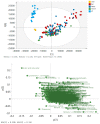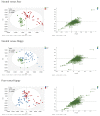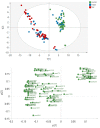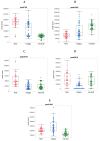Chemical Fingerprints of Emotional Body Odor
- PMID: 32121157
- PMCID: PMC7142800
- DOI: 10.3390/metabo10030084
Chemical Fingerprints of Emotional Body Odor
Abstract
Chemical communication is common among animals. In humans, the chemical basis of social communication has remained a black box, despite psychological and neural research showing distinctive physiological, behavioral, and neural consequences of body odors emitted during emotional states like fear and happiness. We used a multidisciplinary approach to examine whether molecular cues could be associated with an emotional state in the emitter. Our research revealed that the volatile molecules transmitting different emotions to perceivers also have objectively different chemical properties. Chemical analysis of underarm sweat collected from the same donors in fearful, happy, and emotionally neutral states was conducted using untargeted two-dimensional (GC×GC) coupled with time of flight (ToF) MS-based profiling. Based on the multivariate statistical analyses, we find that the pattern of chemical volatiles (N = 1655 peaks) associated with fearful state is clearly different from that associated with (pleasant) neutral state. Happy sweat is also significantly different from the other states, chemically, but shows a bipolar pattern of overlap with fearful as well as neutral state. Candidate chemical classes associated with emotional and neutral sweat have been identified, specifically, linear aldehydes, ketones, esters, and cyclic molecules (5 rings). This research constitutes a first step toward identifying the chemical fingerprints of emotion.
Keywords: body odor; chemical fingerprint; chemosignaling; gas chromatography-mass spectrometry; odor perception; pheromones; volatile organic compounds (VOCs); volatilome.
Conflict of interest statement
This study was funded by Unilever. Unilever is Fast-Moving Consumer Goods company that sells Beauty and Personal Care products. All authors declare no potential (financial nor non-financial) conflicts of interest. Unilever authors were involved in chemical analyses of human sweat and relevant statistical analyses. The design of the study, sweat collection, and statistical analyses related to human self-report data was led by the authors from Utrecht University.
Figures








References
Grants and funding
LinkOut - more resources
Full Text Sources
Medical

